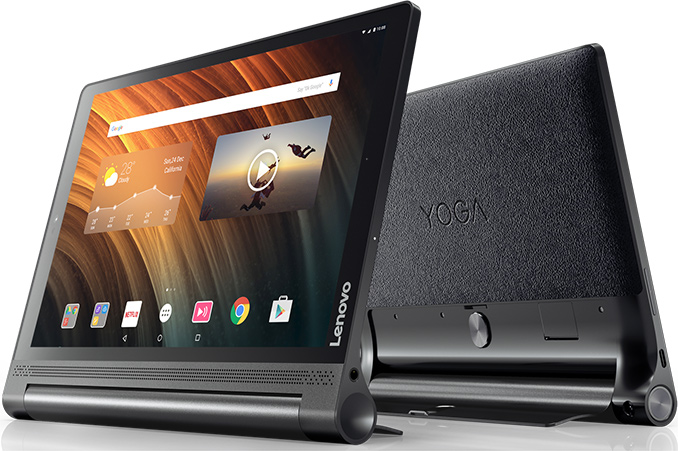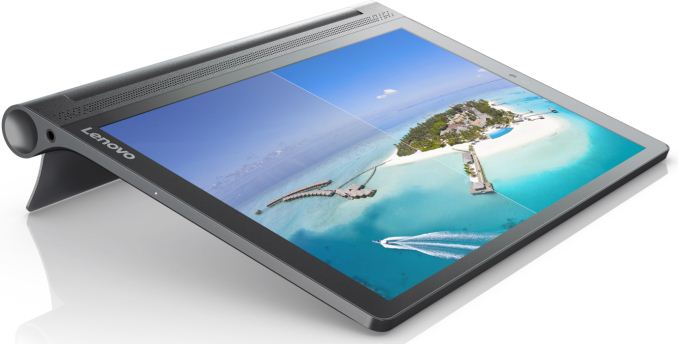Lenovo Yoga Tab 3 Plus: Snapdragon 652, 10-Inch 2K Display, JBL Speakers and USB-C
by Anton Shilov on August 31, 2016 2:35 PM EST
Lenovo has introduced a new member to its Yoga Tab 3 product family this week at IFA. The new Yoga Tab 3 Plus tablet runs Google Android 6.0 and is aimed at demanding consumers. The novelty comes with a number of features previously only available on the Yoga Tab 3 Pro, including a higher-end octa-core SoC, a 2K 10” display, a lot of RAM, plenty of storage as well as Wi-Fi 802.11 ac connectivity. Surprisingly, the Yoga Tab 3 Plus will not be too expensive and will be available starting from $299.
When Lenovo introduced its Yoga Tab 3 family of products last year, the company drew a clear line between its mainstream Yoga Tab and considerably more advanced Yoga Tab 3 Pro tablets. The former were based on entry-level SoCs and were equipped with relatively low-res screens and limited amount of DRAM/NAND, whereas the latter were powered by Intel’s Atom SoC, were equipped with 2560×1600 displays and featured considerably better specs in general, but at a much higher price ($499/$599 for Wi-Fi/Wi-Fi+LTE model). Today, the Yoga Tab 3 closes the gap between the two product lines and attempts to wed the best of both: affordable price and high-end specs.
The Yoga Tab 3 Plus is based on the Qualcomm Snapdragon 652 SoC (4×A72 1.8 GHz, 4×A53 1.4 GHz, Qualcomm Adreno 510 graphics) and comes equipped with 3 GB of LPDDR3 DRAM as well as 32 GB of NAND flash storage (it also has a microSD card slot). The tablet uses USB Type-C (operates in USB 2.0 mode) connector for charging and connectivity and also supports WiFi 802.11 a/b/g/n/ac, Bluetooth 4.0 and LTE (optional) wireless technologies.
| Lenovo Yoga Tab 3 Family | ||||
| Model | Yoga Tab 3 8" | Yoga Tab 3 10" | Yoga Tab 3 Pro 10" | Yoga Tab 3 Plus 10" |
| SoC | Snapdragon 212 4×Cortex-A7 at 1.3GHz Adreno 304 graphics |
Intel Atom x5-Z8500 Quad core, 2.24GHz |
Snapdragon 652 4×Cortex-A72 at 1.8GHz 4×Cortex-A53 at 1.4 GHz Adreno 510 graphics |
|
| RAM, NAND | 1GB, 16GB NAND + MicroSD | 2GB RAM, 16/32GB NAND + MicroSD |
3GB RAM, 32GB NAND + MicroSD |
|
| Display | 8" 1280x800 IPS LCD | 10.1" 1280x800 IPS LCD | 10.1" 2560x1600 IPS LCD 299 ppi, 70% Color Gamut |
|
| Dimensions | 210 x 146 x 3 to 7mm | 253 x 185 x 3.5 to 9.5mm 655g |
179 x 247 x 4.6mm at thinnest point, 665g | 179 x 247 x 4.68mm at thinnest point, 637-644g |
| Camera | 8MP Rotatable Camera | 13MP Rear-facing 5MP Front-facing |
||
| Battery | 6200mAh (23.56Wh) | 8700mAh (33.06Wh) | 10200mAh (38.76Wh) | 9300mAh |
| OS | Android 5.1 Lollipop | Android 5.0 Lollipop | Android 5.1 Lollipop | Android 6.0 |
| Connectivity | 802.11b/g/n + BT 4.0, microUSB 2.0, Optional LTE SKU | 2x2 802.11a/b/g/n/ac + BT 4.0, microUSB 2.0, Optional LTE |
2x2 802.11a/b/g/n/ac + BT 4.0, USB-C, Optional LTE |
|
Lenovo positions its Yoga Tab 3 Plus tablet for those, who want to have enhanced multimedia experience on-the-go, which is why its 10-point multitouch 10.1” WQXGA (2560×1600) IPS display comes with Technicolor’s color enhance software technology. In addition, the device is equipped with four front-facing speakers (made by JBL) and supports Dolby's Atmos 3D surround sound processing. Now, unlike the Yoga Tab 3 Pro, the Tab 3 Plus does not feature a pico projector, but just like the aforementioned model, it has two cameras.
Battery capacity of the novelty is 9300 mAh and Lenovo claims that the Yoga Tab 3 Plus will last up to 18 hours on its battery. As it turns out, slightly lower battery capacity of the Yoga Tab 3 Plus compared to the Yoga Tab 3 Pro is offset by better energy efficiency of its SoC, which is why it promises to deliver similar battery life. Besides long battery life, the Yoga Tab 3 Plus also inherited premium chassis featuring metal, plastic and leather from the Pro model.
Lenovo will start shipments of its Yoga Tab 3 Plus this October. The MSRP for the Wi-Fi-only model will be $299, but the recommended price of the LTE SKU is currently unknown.
Source: Lenovo

















33 Comments
View All Comments
MrCommunistGen - Wednesday, August 31, 2016 - link
There have been other devices. The Samsung Galaxy A9 is the first that comes to mind but there are additional examples.patel21 - Wednesday, August 31, 2016 - link
Xiaomi Mi MaxR0H1T - Thursday, September 1, 2016 - link
@icrf The le2 (in India) also comes with the SD652, though the SD650 was the first with A72 cores for the masses & it's been a smashing success with many products.The SD652 generally overheats, as compared to SD650, inside a phone therefore a tablet is much better for it's thermal profile however 3GB RAM is grossly inadequate for any tablet of today, especially with Android.
LordConrad - Thursday, September 1, 2016 - link
My Nexus 9 tablet has 2GB RAM and works great. I never have memory issues as Android is designed to automatically close apps (starting with the least used first) when it needs more RAM.UtilityMax - Saturday, September 17, 2016 - link
This model works quite poorly. On my Nexus 5X phone I constantly switch between the web browser and music player. Well, every second time the music player has to reload, which basically proves that either 2GB of RAM is not enough, or the memory management algorithm is quite poor.UtilityMax - Wednesday, October 12, 2016 - link
Actually, this year Samsung quietly refreshed its Galaxy Tab S2 tablets with the SD652. The results are impressive. For the example, the new tablets get Geekbench 4 single core score over 1400 which is a 50% improvement over the 2014 Galaxy Tab S, and also quite a bit over the original S2.WolfRunner - Wednesday, August 31, 2016 - link
Lenovo's website says the 3 Plus is Windows not Android.Lolimaster - Wednesday, August 31, 2016 - link
Tablets at this point should use OLED.LordConrad - Thursday, September 1, 2016 - link
I prefer IPS LCD, easier to see outdoors and no oversaturated colors. Plus, most OLED screens on mobile devices are Pentile... I hate Pentile.MrCommunistGen - Friday, September 2, 2016 - link
At least some recent AMOLED panels have had excellent color accuracy when put into an appropriate sRGB mode. No oversaturated colors there...